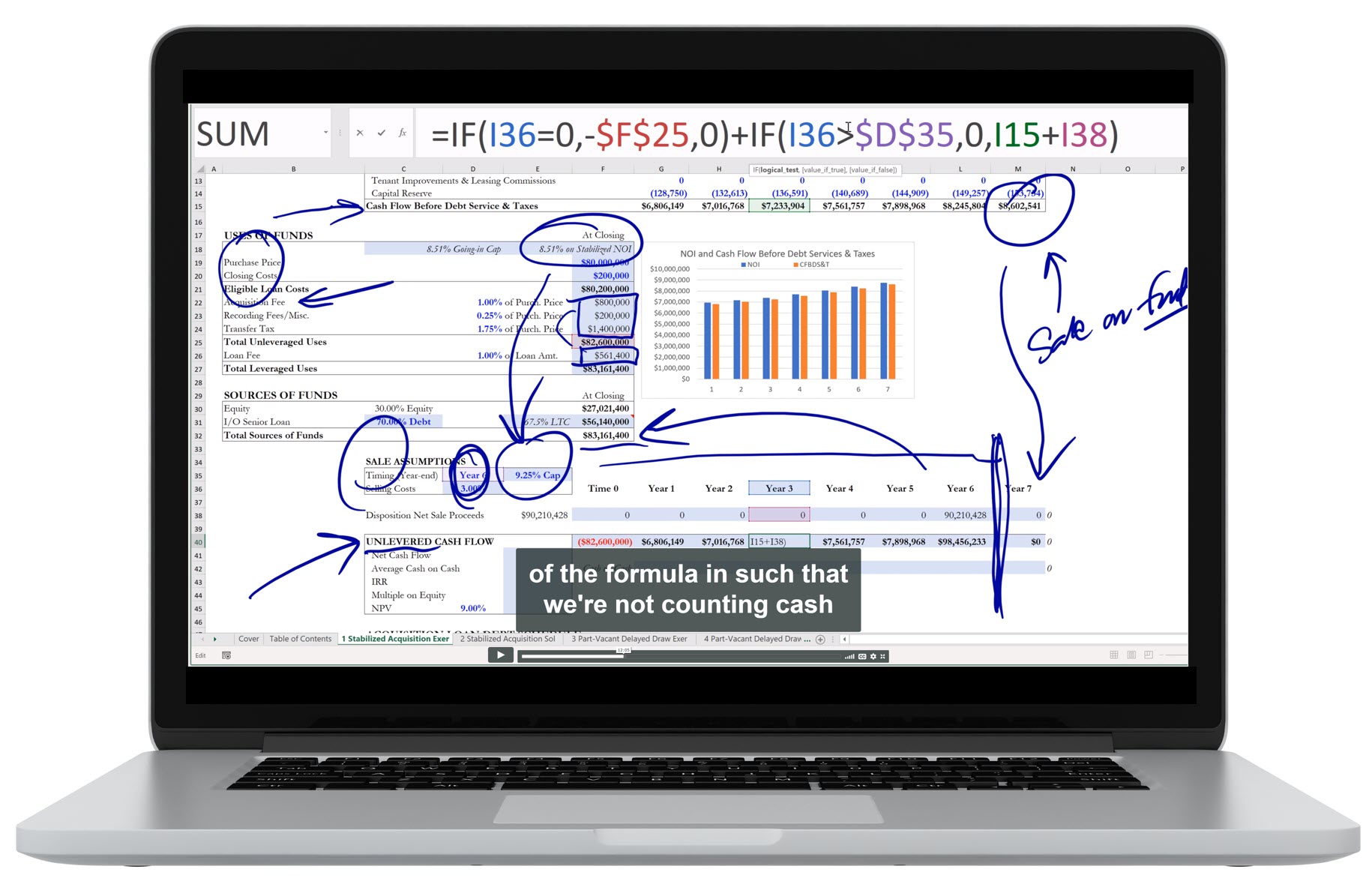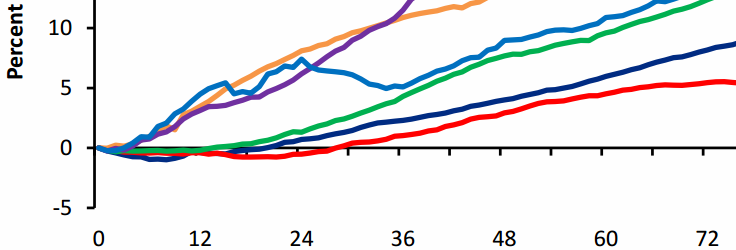Overview
This chapter focuses on what can happen when a borrower defaults on a senior mortgage loan. One distressed loan resolution option is bankruptcy. Senior lenders have contractual rights to cash flows and collateral throughout the life of a loan. Lenders also may have the right to foreclose on a property if the borrower violates the terms of the loan agreement. In foreclosure, a lender with a first security position can theoretically take control of the property and sell it through an auction. In such a situation, the borrower may be responsible for capital gains taxes resulting from the foreclosure or bankruptcy process.
Summary
Listen to this narration if you prefer
Distressed loans can be resolved through restructuring, dissolution, or through the borrower filing for bankruptcy protection. Bankruptcy laws in the U.S. afford borrowers certain rights. Additionally, bankruptcy law trumps contract law. There are two basic types of bankruptcies in the US: Chapter 7 and Chapter 11. In a Chapter 7 bankruptcy, the debtor ceases all operations, goes completely out of business, and a trustee is appointed to sell the property and other assets in an attempt to pay off obligations through this liquidation. In a Chapter 11 bankruptcy, the process attempts to conserve going-concern value, generally requiring a consensual plan of reorganization. Chapter 11 bankruptcy law permits a borrower to prevent a lender from immediately seizing an asset.
U.S. bankruptcy law allows for debtor in possession financing. This allows the defaulting party to subordinate existing debt claims to new debt, which is taken on to operate the business as it attempts to emerge from bankruptcy. Additionally under Chapter 11, borrowers do not have to pay interest, can choose not to pay rent, cannot be immediately evicted, may break leases, and may sublet space. The bankruptcy court’s job is to supervise the attempt to maximize the value of all assets.
The absolute priority rule states that no junior creditor will receive consideration until all senior creditors are paid in full, and no equity holder will receive consideration until all creditors have been paid in full (including interest). The new value exception to the absolute priority rule allows a debtor to contribute fresh capital in exchange for the ownership of the property as it exits bankruptcy. The Bank of America vs. La Salle Street Partners case requires the new equity position to be offered to the market and not simply to the original owner.
In Chapter 11, both recourse and non-recourse lenders are permitted to file an unsecured deficiency claim when the value of the property is not sufficient to cover the entirety of creditors’ outstanding debt. Under section 11.11B, the lender can waive a deficiency claim. A lender would only waive a deficiency claim if they believe that the debtor will fail again, in which case the lender would retain the larger secured claim. If the lender accepted the deficiency claim and the property subsequently defaulted, the lender would only have the secured claim. This option is available only during Chapter 11 protection.
As a borrower, one can use bankruptcy both offensively and defensively, so be sure to understand one’s rights and restrictions under bankruptcy laws before taking out a loan.
Questions
These are the types of questions you’ll be able to answer after studying the full chapter.
1. Please explain how Chapter 7 and Chapter 11 bankruptcies differ in the U.S.
2. Please explain why an owner who is foreclosed upon would have to pay capital gains taxes.
3. Why would a lender waive a deficiency claim?
Audio Interview
Chapter 7 versus Chapter 11 bankruptcy (5:14)
BRUCE KIRSCH: We learn about the two types of corporate bankruptcy in the US– Chapter 7 and Chapter 11 bankruptcy. Now when most people hear that a company has gone bankrupt, the mental image that appears is a boarded-up factory and there’s empty offices. And nobody’s there. The phones are disconnected, or ringing and nobody’s there to answer them. And, in essence, the company really has no value left in it.
Now that image could be appropriate to describe Chapter 7 but not Chapter 11. How is Chapter 11 bankruptcy different?
PETER LINNEMAN: Well I think it’s important to understand that when people say “chapter,” what they’re referring to is a chapter of the US Bankruptcy Code or its equivalent. But let’s stay within the US because that’s the context we’re talking about.
So when you sign any contract, that contract operates under the auspices of the United States and all of its laws. Included in all those laws is that you have the right to bankruptcy if things don’t work out. And the Bankruptcy Code and its various chapters say what happens if you choose to use that. And, in fact, you don’t even mention that in the original contract because it’s subsumed it’s a matter of law that that framework exists to deal with those situations.
Chapter 7 says, I am no longer a going concern. The company is not viable. The entity is not viable. And that does happen sometimes for commercial real estate, but not often. Usually the property has viability. There are tenants, or there should be tenants, and therefore the entity itself, the building, is generally a viable, going concern, so that you don’t generally see Chapter 7 used on a property.
More typical is chapter 11 where the asset is viable. It’s a question of, how do I deal with the fact that I either do not have sufficient liquidity to satisfy all my creditors at the moment, or how do I deal with the fact that there is no liquidity. And though I may have enough value to satisfy all my creditors, I cannot access that value.
That comes up frequently in real estate because it’s an illiquid asset. So I could have a situation where, yeah, my assets generating a million cash flow and even at a 10 cap it’s worth $10 million, and I have a $9 million loan due. But no one will make me a loan for $9 million and to sell the property for $10 million could take me six to 18 months because of the illiquidity of the asset. And I don’t want to do a fire sale. And so, given the illiquidity of the asset, I may have a shortfall in terms of liquidity.
Alternatively, I may have a situation where temporarily– or at least I believe temporarily– my asset is worth less than my liability. But if you give me time, I believe the asset will recover its value such that the asset’s worth more than the liability. And you just got to give me time to bridge my way to it.
That’s what Chapter 11 is about. And that’s why you’ll hear the phrase “Chapter 11 protection.” And what it’s protecting you from is under the full auspices of US law. Being fully implemented, it is protecting you in your various contractual relationships, including with your lenders, your employees, et cetera. It’s protecting you from them squeezing you out on a temporary shortfall of liquidity or a temporary impairment of value relative to liabilities. And it’s giving you time within a very prescribed framework to work out how to get liquidity or how to work out that all the creditors get paid in full. But it may take longer to repay them.
The most notable example of what happened was in the 2008-2009 crisis. There were no loans available to anybody, at any price. If your loan came due then, it almost didn’t matter what your asset value was because no one was going to make any loan to anybody for anything. Therefore, you would be in default of your loan, even though the value of the property could be way in excess of the loan, but you could never realize it in time to pay off the loan because of the illiquidity.
How Chapter 11 bankruptcy saved General Growth Properties and wound down Lehman (9:28)
DR. PETER LINNEMAN: Chapter 11 bankruptcy allowed, most notably, general growth properties the opportunity to go in and say, wait, we have asset value way in excess of our liabilities. Just about our cash flow, we have tremendous amount of cash flow. Apply even a distress cap rate to that, and we have asset value way in excess of our liabilities. Don’t allow the Lenders to come in and take our assets when there’s nobody making a loan, and in effect steal our value. And they went to chapter 11 protection, and it worked out exactly as planned, namely, given time, everybody is going to get paid, and given time, the values recovered, et cetera. And by the way, the thing I always point out to students is, never forget that when you sign a lease, when you sign a mortgage, when you sign a labor contract, those contracts can always be trumped by bankruptcy law- by their very nature, all of them. Bankruptcy law trumps contract law. That’s the way the law is set up, so you just have to remember that when you’re looking at those contracts.
BRUCE KIRSCH: And so you mentioned how general growth properties had taken a path to get through bankruptcy, in essence, and then they emerged from bankruptcy.
DR. PETER LINNEMAN: Yes, they emerged, it took them about 18, 20 months. When they did that they lost control of a lot of dimensions of their business during that period. Because under bankruptcy chapter 11 you have to get approval for major expenditures from the bankruptcy judge, so that the bankruptcy judge is satisfied that you’re not taking money out to benefit employees at the expense of creditors, you’re not impairing value by your decisions, et cetera. So suddenly you’re relying on the court to make a lot of determinations on how you run your business, which is scary, and it’s expensive, because everybody has to hire lawyers to argue, this is what I want to do, and here’s why. And all those lawyers are being paid, the expense is enormous. But that’s what the system is set up for, and in the case of general growth, it really worked exactly as designed. It preserved long term value. It was an expensive process with a lot of lawyers being paid a lot of money, a lot of accountants and consultants being paid a lot of money. But in the end, the shareholders, the equity holders did not get squeezed out on a temporary liquidity issue when there was plenty of value in a longer term sense.
BRUCE KIRSCH: This is an example of the success of the chapter 11 structure, and how it can help to shepherd a company through a time of severe liquidity, and then reemerge. What is the difference between what happened there and where we see currently Lehman Brothers, which went bankrupt, and declared bankruptcy in 2008- and yet we still hear about them in the news as selling assets such as Archstone Communities. Now is Lehman potentially going to become a going concern again?
DR. PETER LINNEMAN: Lehman emerged from bankruptcy a few months ago. They have a board, as part of their emergence from bankruptcy they have to liquidate the company, that was the agreement. So the agreement was they stayed in bankruptcy, I believe about three years, they emerged from bankruptcy. There is a board with a fiduciary duty to maximize the value for the new shareholders, which are essentially all the old lenders. So the lenders became shareholders as part of the coming out of chapter 11. The new deal turned out that the assets weren’t worth more than the liabilities. The old shareholders were wiped out. The old lenders became the new shareholders. Under a plan, the company came out of bankruptcy, and became a liquidating company. They are literally a liquidating company, there are certain dimensions of the US tax code that then apply, but they’re a liquidating company and the board evaluates, should we sell this now or should we hang on a little bit, and they are literally liquidating the company down. And I would argue that was a very complex and expensive chapter 11, but it again worked, it took time, it preserved value. It was a difficult process because of the high leverage involved. The reason the high leverage made it very difficult is, imagine a company that has 70% loan devalue. You’ve got a 30% value cushion where Bruce comes in and says, I think it’s worth somewhere between 65 and 75, and you could say, OK, this is worth trying to save. Now imagine a company with 97% debt on 100 value, and you’re going, boy, the margin of error, just isn’t very much. And it turned out that the extreme leverage meant that the assets were worth less than the liabilities, but they could still work it through– say no, we’ve now decided, shareholders, you don’t have any skin in the game, therefore you’re wiped out– but you did it in an orderly manner that you looked at it, a prescribed manner. And then you said, there are rules, how the debt holders get dealt with, and then that was dealt with, and then they decided to liquidate. So my understanding is Lehman is not an operating concern, it’s a liquidating concern, but that does mean they have to operate certain assets until they liquidate.
BRUCE KIRSCH: And so it seems like the key differentiator between the general growth scenario and the Lehman scenario is the huge gulf in between the net worth of the company, whether it was liquid or not.
DR. PETER LINNEMAN: Yeah, I’ll give you a real simple number that I kept being struck by, is that the interest coverage ratio at general growth– I’m doing this from memory– was something like 1.6 times, that is they had 60% more income than needed to cover their interest payments. When that is true, throughout most of history, it means that the equity– I mean if you go through all your math, and all your analysis, and all your norms– it means the equity is worth somewhere between 20% and 40% of the capital stack, with debt being worth the rest. Well, when I had 1.6 interest coverage, you’d say, even if my income fell by 10%, I still have 1.44 interest coverage, and even if the interest rate went up some, I still had 1.3 interest coverage. And at 1.3 interest coverage you’d normally have 20, 25% of the company being equity, and the rest being debt. So you knew that there was a lot of equity there. The problem in general growth was no one would roll over and renew any loan. So their job was to show up to the courts, and say, Your Honor, we’re willing to pay all our loans in full, we’re willing to honor all our contracts in full, we simply need them to change one term, namely, extend the loan two more years, and give this window of crisis a chance to go by to where people are willing to make loans again. We’ll pay everybody back in full, we can pay all the interest on it while we’re going, we can honor all our contracts. The difference in Lehman is, if you did it, they didn’t have enough income to cover their interest payments, and it wasn’t just temporary they didn’t have enough income to cover their interest payments, it was a sustained situation. The liabilities were more than the assets, and then you had to first determine if that’s true and then given that’s true, what do you do from there.
BRUCE KIRSCH: And so at the end of the day, does that determination come from a judge?
DR. PETER LINNEMAN: In the end it’s done by a judge. It’s done by the various claimants, equity holders, Lenders, and other creditors, kind of negotiating, but it’s all occurring under a prescribed set of priorities under the law, subject to the blessing of a bankruptcy judge that only does this type of stuff. And so in the process they have to bless it, and getting all those negotiations together where people can be bless it, ultimately, takes time and lawyers.
Key Terms
To view the definition, click or press on the term. Repeat to hide the definition.
When the agreed upon debt service payments have ceased being made when they are due.
Making all missed payments to bring the loan payments current.
When the borrower fails to cure their delinquency.
A loan that is in default. Also referred to as an N.P.L.
Changing the terms of an outstanding loan so that it can once again be current and ultimately be repaid. The interest rate and/or amortization term can be modified to reduce the monthly debt service payment to make it affordable to the borrower; can be done temporarily or undone once the ability to pay in full (per the original terms) has been restored.
A property sale whose proceeds are not sufficient to pay back the full amount owed on the mortgage.
Real property that sits on the liability side of a lender’s balance sheet after the lender forecloses on the defaulted borrower.
The principal amount borrowed which has not yet been repaid to the lender.
A investor that buys distressed mortgage notes from lenders at discounts to the unpaid principal balances.
Legal protection for borrowers from their creditors; bankruptcy law provides a structured mechanism by which debtors unable to meet the terms of their credit agreements can attempt to resolve their debts and other liabilities.
The legal encumbrance that gives the senior lender the right to the first position for receipt of property-related cash flow.
When a lender with a first security position takes control of the property from a defaulted borrower.
Those with positions subordinate to the senior debt.
The debtor creases all operations, goes completely out of business, and a trustee is appointed to sell the property and other assets in order to pay off obligations with sale proceeds.
Created in 1978 to formalize the business reorganization framework. Codified the view that reorganization of the business is generally preferred to liquidation.
Allows the defaulting borrower to subordinate existing debt claims to new debt which is taken on to operate the business while it attempts a successful reorganization.
No junior creditor will receive consideration until all senior creditors are paid in full, and no equity holder will receive consideration until all creditors have been paid in full (including interest).
The debtor proposed contributing fresh capital in exchange for the 100% ownership of the property as it exited bankruptcy.
The value of the property is not sufficient to repay the entirety of the creditors’ outstanding debt.
Debt not backed up by an underlying asset.
The imposition of a bankruptcy reorganization plan by a court despite any objections by certain classes of creditors.
Mortgages for which the creditor can only look to the property to recoup owed principal and interest.
The difference between the loan value and the collateral value is the deficiency claim against the borrower which becomes part of the unsecured claims pool.
Chapter Headings
- Distressed Loan Resolution Options
- Loan Restructuring
- Dissolution Options
- Bankruptcy
- Borrowers’ Rights
- Bank of America Versus La Salle Street Partners
- Section 11.11B
Learn about REFAI Certification
< Ch 12 | Real Estate Company Analysis
Ch 14 | Should You Borrow? >
Table of Contents
Index
Buy the Book










